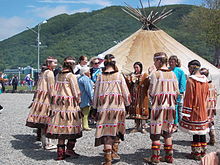
Vitus Jonassen Bering, also known as Ivan Ivanovich Bering, was a Danish-born Russian cartographer and explorer, and an officer in the Russian Navy. He is known as a leader of two Russian expeditions, namely the First Kamchatka Expedition and the Great Northern Expedition, exploring the north-eastern coast of the Asian continent and from there the western coast on the North American continent. The Bering Strait, the Bering Sea, Bering Island, the Bering Glacier, and Vitus Lake were all named in his honor.
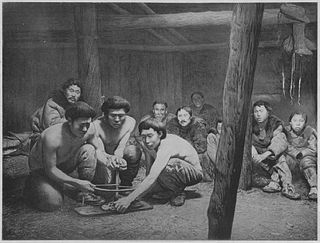
Koryaks are an Indigenous people of the Russian Far East, who live immediately north of the Kamchatka Peninsula in Kamchatka Krai and inhabit the coastlands of the Bering Sea. The cultural borders of the Koryaks include Tigilsk in the south and the Anadyr basin in the north.
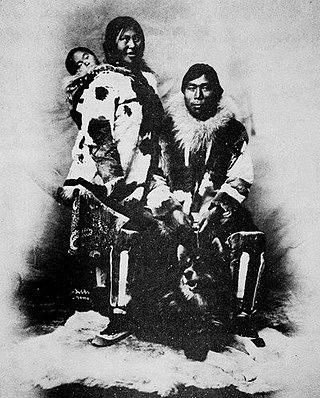
The Chukchi, or Chukchee, are a Siberian ethnic group native to the Chukchi Peninsula, the shores of the Chukchi Sea and the Bering Sea region of the Arctic Ocean all within modern Russia. They speak the Chukchi language. The Chukchi originated from the people living around the Okhotsk Sea.
Vladimir Vasilyevich Atlasov or Otlasov was a Siberian Cossack who was the first Russian to organize systematic exploration of the Kamchatka Peninsula. Atlasov Island, an uninhabited volcanic island off the southern tip of Kamchatka, and the Atlasova volcano are named after him.
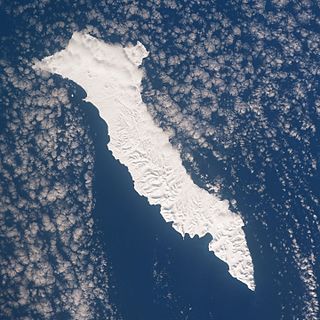
Bering Island is located off the Kamchatka Peninsula in the Bering Sea.
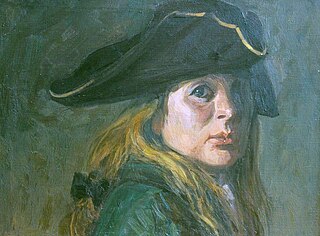
Georg Wilhelm Steller was a German-born naturalist and explorer who contributed to the fields of biology, zoology, and ethnography. He participated in the Great Northern Expedition (1733–1743) and his observations of the natural world helped the exploration and documentation of the flora and fauna of the North Pacific region.

The Chukotko-Kamchatkan or Chukchi–Kamchatkan languages are a language family of extreme northeastern Siberia. Its speakers traditionally were indigenous hunter-gatherers and reindeer-herders. Chukotko-Kamchatkan is endangered. The Kamchatkan branch is moribund, represented only by Western Itelmen, with less than a hundred speakers left. The Chukotkan branch had close to 7,000 speakers left, with a reported total ethnic population of 25,000.

The Kamchatka Peninsula is a 1,250-kilometre-long (777 mi) peninsula in the Russian Far East, with an area of about 270,000 km2 (100,000 sq mi). The Pacific Ocean and the Sea of Okhotsk make up the peninsula's eastern and western coastlines, respectively. Immediately offshore along the Pacific coast of the peninsula runs the 10,500-metre-deep (34,449 ft) Kuril–Kamchatka Trench.

The Commander Islands, Komandorski Islands, or Komandorskie Islands are a series of islands in the Russian Far East, a part of the Aleutian Islands, located about 175 km (109 mi) east of the Kamchatka Peninsula in the Bering Sea. Treeless and sparsely populated, the islands consist of Bering Island, Medny Island and fifteen islets and rocks. The largest of the latter are Tufted Puffin Rock (Kamen Toporkov or Ostrov Toporkov), 15 ha, and Kamen Ariy, which are between 3 km (1.9 mi) and 13 km (8.1 mi) west of the only settlement, Nikolskoye. Administratively, the Commanders compose the Aleutsky District of the Kamchatka Krai in Russia.
The Kamchadals inhabit Kamchatka, Russia. The name "Kamchadal" was applied to the descendants of the local Siberians and aboriginal peoples who assimilated with the Russians. The descendants of the mixed-blood Russian settlers in 18th-19th century are called Kamchadals these days. The Kamchadals speak Russian with a touch of local dialects of the aboriginal languages of Kamchatka. The Kamchadals engage in fur trading, fishing, market gardening and dairy farming, and are of the Russian Orthodox faith. The Kamchadal language was a Kamchatka creole with Russian and indigenous elements.

Itelmen or Western Itelmen, formerly known as Western Kamchadal, is a language of the Chukotko-Kamchatkan family spoken on the western coast of the Kamchatka Peninsula. Fewer than a hundred native speakers, mostly elderly, in a few settlements in the southwest of Koryak Autonomous Okrug, remained in 1993. The 2021 Census counted 2,596 ethnic Itelmens, virtually all of whom are now monolingual in Russian. However, there are attempts to revive the language, and it is being taught in a number of schools in the region.

Stepan Petrovich Krasheninnikov was a Russian explorer of Siberia, naturalist and geographer who gave the first full description of Kamchatka in the early 18th century. He was elected to the Russian Academy of Sciences in 1745. The Krasheninnikov Volcano on Kamchatka is named in his honour.
The Alyutors are an ethnic group who live on the Kamchatka Peninsula and Chukchi Peninsula of the Russian Far East. Today most of them live in Koryak Okrug of Kamchatka Krai.

The Russian conquest of Siberia took place during 1580–1778, when the Khanate of Sibir became a loose political structure of vassalages that were being undermined by the activities of Russian explorers. Although outnumbered, the Russians pressured the various family-based tribes into changing their loyalties and establishing distant forts from which they conducted raids. It is traditionally considered that Yermak Timofeyevich's campaign against the Siberian Khanate began in 1580. The annexation of Siberia and the Far East to Russia was resisted by local residents and took place against the backdrop of fierce battles between the Indigenous peoples of Siberia and the Russian Cossacks, who often committed atrocities against Indigenous Siberians.
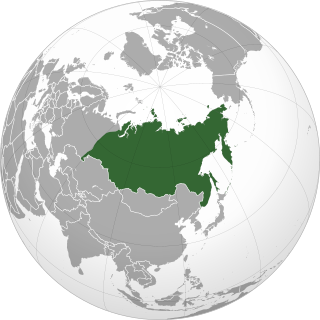
Siberia is a vast region spanning the northern part of the Asian continent and forming the Asiatic portion of Russia. As a result of the Russian conquest of Siberia and of the subsequent population movements during the Soviet era (1917–1991), the modern-day demographics of Siberia is dominated by ethnic Russians (Siberiaks) and other Slavs. However, there remains a slowly increasing number of Indigenous groups, accounting for about 5% of the total Siberian population, some of which are closely genetically related to Indigenous peoples of the Americas.

Kutkh is a Raven spirit traditionally revered in various forms by various indigenous peoples of the Russian Far East. Kutkh appears in many legends: as a key figure in creation, as a fertile ancestor of mankind, as a mighty shaman and as a trickster. He is a popular subject of the animist stories of the Chukchi people and plays a central role in the mythology of the Koryaks and Itelmens of Kamchatka. Many of the stories regarding Kutkh are similar to those of the Raven among the indigenous peoples of the Pacific Northwest Coast, suggesting a long history of indirect cultural contact between Asian and North American peoples.
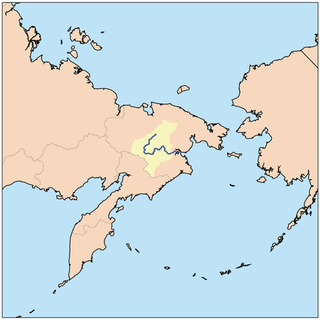
Anadyrsk was an important Russian ostrog in far northeastern Siberia from 1649 to 1764. It was on the Anadyr River, near the head of small-boat navigation, about 300 miles upstream, 12 miles northeast of the present Markovo.

Fedot Alekseyevich Popov was a Russian explorer who organized the first European expedition through the Bering Strait.

The Ainu in Russia are an Indigenous people of Siberia located in Sakhalin Oblast, Khabarovsk Krai and Kamchatka Krai. The Russian Ainu people, also called Kurile, Kamchatka's Kurile or Eine, can be subdivided into six groups.
The Kamchatka Sled Dog is a rare landrace of sled laika developed by the Itelmen and Koryak people of Kamchatka, Russia. There are currently efforts underway to revive the breed. A standard for the Kamchatka Sled Dog was approved by the Russian Federation of Service Dog Breeding in February of 1992.
